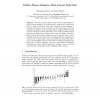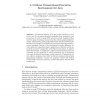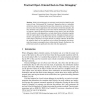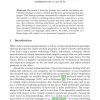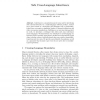ECOOP
2008
Springer
14 years 9 months ago
2008
Springer
Good data layouts improve cache and TLB performance of object-oriented software, but unfortunately, selecting an optimal data layout a priori is NP-hard. This paper introduces layo...
ECOOP
2008
Springer
14 years 9 months ago
2008
Springer
Abstract. Transactional memory (TM) has recently emerged as an effective tool for extracting fine-grain parallelism from declarative critical sections. In order to make STM systems...
ECOOP
2008
Springer
14 years 9 months ago
2008
Springer
Back-in-time debuggers are extremely useful tools for identifying the causes of bugs. Unfortunately the "omniscient" approaches that try to remember all previous states a...
ECOOP
2008
Springer
14 years 9 months ago
2008
Springer
Abstract We present a datatype package that enables the shallow embedding technique to object-oriented specification and programming languages. This datatype package incrementally ...
ECOOP
2008
Springer
14 years 9 months ago
2008
Springer
Abstract. The paradigm shift in processor design from monolithic processors to multicore has renewed interest in programming models that facilitate parallelism. While multicores ar...
ECOOP
2008
Springer
14 years 9 months ago
2008
Springer
ECOOP
2008
Springer
14 years 9 months ago
2008
Springer
Implicit invocation (II) and aspect-oriented (AO) languages provide related but distinct mechanisms for separation of concerns. II languages have explicitly announced events that r...
ECOOP
2008
Springer
14 years 9 months ago
2008
Springer
Abstract. Lightweight bytecode verification uses stack maps to annotate Java bytecode programs with type information in order to reduce the verification to type checking. This pape...
ECOOP
2008
Springer
14 years 9 months ago
2008
Springer
Inheritance is a standard means for reuse and for interfacing with external libraries. In a multi-language software product, extending a class written in a statically-typed languag...
ECOOP
2008
Springer
14 years 9 months ago
2008
Springer
We present Bristlecone, a programming language for robust software systems. Bristlecone applications have two components: a high-level organization description that specifies how t...
